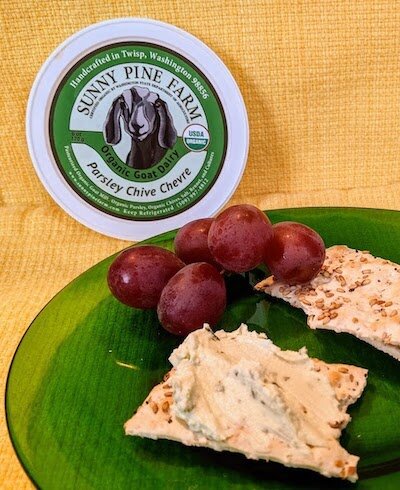6 Great Cheeses from Washington State
Washington State is typically known for eerie, atmosphere-laden TV shows and films. As for food, it’s apples, cherries and an abundance of fresh seafood, including the naughty-looking geoduck (pronounced gooey-duck) that visiting food TV show hosts love to snicker about. It seems the state’s best-kept secret is its abundance of high-quality cheese.
Washington is currently home to more than 80 cheesemakers crafting 200-plus artisan and farmstead cheeses, some of the finest the United States has to offer. Milk from locally raised cattle, sheep and goats that graze the state’s lush, verdant pastures—and you thought it was all spooky forests—goes into the creation of an array of winning cheeses, from fresh chevres to earthy washed rind cheeses to bright, rich blues.
Sunny Pine Farm Chevre, from Sunny Pine Farm
Sunny Pine Farm began in the 1990s with a peculiar housewarming gift—a goat. Located in the Okanagan county close the border of Canada, this family enterprise turns out an array of bright, lightly tart, certified organic cheeses. Made from pasteurized goats’ milk, these super creamy chevres deliver just the right tart-to-flavor ratio, providing gentle pucker power. In addition to a plain chevre, their savory flavors include parsley chive, garlic basil and black pepper garlic. They also make a honey lavender chevre that, smeared on a toasted bagel, makes a lovely start to the day. Top a salad with rounds of one of the savory chevres or melt some over roasted potatoes.
Caciotta, from Ferndale Farmstead
Ferndale Farmstead
“Caciotta” is a style of mild, creamy cheese that’s made throughout Italy. This one from Ferndale Farmstead is a traditionally crafted, semi-aged cheese made from the pasteurized milk of their own cows, using heirloom cultures and enzymes sourced from Naples. Pale yellow with a few fine air pockets, it’s delicately flavored and good for eating out of hand, a basic cheese-and-crackers kind of cheese. Pair it carefully in cooking, or the delicate flavor will be lost. It’s a great melter for a toasted cheese sandwich with jam. Grate it over scrambled eggs or tuck it into an omelet to enrich those eggs.
Dinah’s Cheese, from Kurtwood Farms
Photo courtesy of Kurtwood Farms
Dinah was the original cow on this Vashon Island farm, and Dinah’s is her namesake cheese. A traditional French camembert-style farmstead cheese, it’s made right there on the farm from the pasteurized milk of a small herd of Jersey cows and then aged in caves dug beneath the pastures they graze. Dinah’s has a snow-white bloomy rind, a straw-colored paste, and a pleasingly funky, mushroomy flavor that lingers but doesn’t outstay its welcome. Try it at room temperature on a good rustic bread with a smear of plum jam. In fact, it goes well with most any stone fruit jam or preserves you have on hand.
Smoked Flagship, from Beecher’s Handmade Cheese
Photo courtesy of Beecher’s Handmade Cheese
Beecher’s Flagship is a cheddar-like cheese that technically isn’t a cheddar. While Beecher’s uses the cheddaring technique of cutting the curd to extract maximum moisture, they don’t actually use cheddar cultures. Still, Flagship’s inviting mouthfeel and tart richness provide a cheddar experience that can fool the tastebuds. Beecher’s Smoked Flagship takes it one step further and is smoked over apple and cherry woods, to create a delicately smoky cheese. While it’s quite enjoyable eaten out of hand with a fruity cider, it really shines when melted, so try it grated over roasted or pan-fried fingerling potatoes. Make it one of the four cheeses you include in your quattro formaggio pizza for lightly smoky depth. You’ll find their store with glassed in cheesemaking facility in the original location at Pike’s Place Market. You can also pick up Beecher’s cheese at SeaTac airport.
Photo courtesy of Cascadia Creamery
Sawtooth, from Cascadia Creamery
Cascadia Creamery ages its Sawtooth washed rind cheese in an actual lava tube cave in the shadow of volcanic Mt. Adams in the Cascade Mountains of southcentral Washington. This setup naturally provides the optimal temperature and humidity level for aging Sawtooth, and Cascadia’s other cheeses, to perfection. Made from raw, organic cow’s milk and aged between 2 and 3 months, Sawtooth has a smooth yet fudgy texture and lightly funky flavor. It is superb at room temperature with a glass of sauvignon blanc. Serve it with stone fruit for the ultimate dessert.
Whatcom Blue, from Twin Sisters Creamery
Photo courtesy of Kristi Coulter
Whatcom Blue is a good beginner blue for those who think they don’t like blue cheese. It’s made of raw cow’s milk in Ferndale, (just minutes away from Ferndale Farmstead) from Jersey cattle raised nearby, inoculated with penicillium roqueforti and aged for a minimum of 60 days. The result is a robust blue with a flavor that is welcoming but doesn’t overwhelm. With its rich, smooth texture, Whatcom Blue is the crowning touch to a satisfying bacon-and blue burger, if you don’t eat it all before the patties are cooked! Or try it on your favorite cracker with a drizzle of honey on top.







